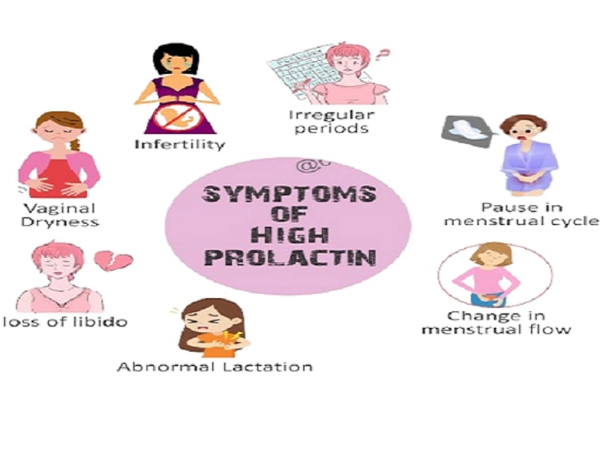Sommaire
- 1 Introduction
- 2 Five lifestyle modifications that may be effective in managing hyperprolactinemia
- 2.1 What is hyperprolactinemia, and what is the cause of its occurrence?
- 2.2 Effects on the Human Body and Indications
- 2.3 Dietary Influences on Prolactin Concentrations
- 2.4 Vitamins and foods that are recommended
- 2.5 Benefits of Physical Activity for Hyperprolactinemia
- 2.6 Exercise Types to Take into Account
- 2.7 Comprehending the correlation between tension and prolactin levels
- 2.8 Stress Relief Strategies and Programmers
- 2.9 The Significance of Quality Sleep in Maintaining Hormonal Balance
- 2.10 Tips for Enhancing the Quality of Your Sleep
- 2.11 Treatments for Hyperprolactinemia That Are Commonly Used
- 2.12 Alternative Therapies
- 2.13 Monitor Prolactin Levels and Symptoms
- 2.14 Providing Medical Professionals with Guidance
- 2.15 Incorporating holistic methodologies
- 2.16 Formulating an Ecological Living Strategy
- 2.17 Étape 1 -
- 2.18 Étape 2 -
- 2.19 Commentaires
Introduction
Five lifestyle modifications that may be effective in managing hyperprolactinemia
Finding effective therapy options may be challenging due to the complexity of hyperprolactinemia. In order to establish a comprehensive strategy for treating the symptoms and consequences of this hormonal imbalance, which is characterized by elevated prolactin levels in the blood, it is essential to comprehend its nature. This article examines five critical lifestyle modifications that may facilitate the successful treatment of hyperprolactinemia. We investigate complementary holistic alternatives to conventional medical care, including the importance of stress management strategies, diet and exercise recommendations, and excellent sleep hygiene. Our goal is to provide individuals with hyperprolactinemia with practical information and solutions that will help them enhance their overall well-being and quality of life.
What is hyperprolactinemia, and what is the cause of its occurrence?
Hyperprolactinemia is defined by the presence of elevated levels of prolactin hormone in the circulation. Chronic renal disease, hypothyroidism, medication, and pituitary gland lesions are among the potential causes.
Cabergoline 0.5mg is used to treat a variety of illnesses that arise from excessive production of the hormone prolactin. It may be used to treat pituitary prolactinomas, which are tumors of the pituitary gland, as well as certain menstruation issues and issues with fertility in both sexes.
Effects on the Human Body and Indications
Infertility, abnormal menstrual cycles, reduced libido in non-pregnant adults, and the ability of non-pregnant women to produce breast milk are all potential consequences of hyperprolactinemia. Elevated prolactin levels may exacerbate the risk of osteoporosis and compromise bone health.
Dietary Influences on Prolactin Concentrations
Although consuming may not be the sole factor contributing to hyperprolactinemia, substances that influence hormone levels in the body may play a role. A diet that is well-balanced may help to maintain the overall equilibrium of hormones and reduce the levels of prolactin.
Vitamins and foods that are recommended
Foods that are rich in omega-3 fatty acids, vitamins B6 and E, zinc, and antioxidants may be beneficial for individuals with hyperprolactinemia. These nutrients may contribute to the enhancement of overall wellness and hormonal equilibrium.
Benefits of Physical Activity for Hyperprolactinemia
Regular exercise may assist in the regulation of prolactin, a hormone. Exercise has the potential to improve overall health, reduce tension, and even alleviate symptoms of hyperprolactinemia.
Exercise Types to Take into Account
Individuals with hyperprolactinemia may experience advantages from engaging in aerobic, strength, and flexibility exercises. Hormonal equilibrium and overall health are fostered by physical activities like swimming, walking, and yoga.
Comprehending the correlation between tension and prolactin levels
Stress has an impact on the regulation of numerous hormones, such as prolactin levels. Hormonal abnormalities that are the consequence of protracted tension may exacerbate hyperprolactinemia symptoms.
Stress Relief Strategies and Programmers
Some stress-relieving therapies, including mindfulness meditation, deep breathing exercises, outdoor activities, and yoga, may assist in the management of tension and the enhancement of hormone balance. It is recommended that individuals with hyperprolactinemia participate in activities that promote wellness and relaxation..
The Significance of Quality Sleep in Maintaining Hormonal Balance
Controlling hyperprolactinemia necessitates adequate slumber. Hormones, primarily prolactin levels, are regulated by sleep. This delicate equilibrium may be compromised and hyperprolactinemia symptoms may be exacerbated by inadequate sleep.
Tips for Enhancing the Quality of Your Sleep
In order to improve sleep hygiene and preserve hormone balance, it is recommended that you establish a consistent bedtime, decorate your bedroom, restrict screen time before bed, and engage in relaxing activities like meditation or deep breathing. The efficacy of hyperprolactinemia management may be significantly influenced by minor adjustments to your nocturnal routine.
Treatments for Hyperprolactinemia That Are Commonly Used
People with hyperprolactinemia frequently receive medication, including dopamine agonists, to lower their prolactin levels. These medications emulate the actions of the hormone dopamine, which assists in the regulation of prolactin levels.
Cabergoline Treat high concentration of the hormone prolactin in the blood is known as hyperprolactinemia. During breastfeeding, the pituitary gland releases the hormone prolactin, which primarily boosts milk production. Among the many health issues that may arise from an abnormal rise in prolactin levels are menstrual cycle abnormalities, infertility, and erectile dysfunction. Cabergoline eliminates these issues by regulating prolactin levels.
Alternative Therapies
Alternative treatments for hyperprolactinemia may encompass lifestyle modifications, such as stress-reduction strategies, herbal supplements, or acupuncture, in addition to conventional treatments.
Monitor Prolactin Levels and Symptoms
In order to evaluate the efficacy of drugs and guarantee that hormone levels are within a safe range, it is necessary to conduct routine blood tests for prolactin levels. The early detection of these changes may be facilitated by the monitoring of symptoms such as migraines, irregular periods, or increased breast milk production.
Providing Medical Professionals with Guidance
Consultation with medical personnel who specialize in hormone abnormalities, such as endocrinologists or gynecologists, is necessary for the management of hyperprolactinemia. They may oversee your advancement, offer suggestions for future initiatives, and modify your management strategy as necessary.
Incorporating holistic methodologies
Comprehensive treatments, including the consumption of a balanced diet, regular exercise, stress reduction through yoga or mindfulness, and emotional support, may all contribute to the improvement of overall health and the treatment of hyperprolactinemia.
Formulating an Ecological Living Strategy
For the long-term treatment of hyperprolactinemia, it is essential to establish a sustainable lifestyle plan that includes healthful activities that are tailored to your individual needs. Building a lifestyle that promotes health and wellness while controlling hyperprolactinemia requires the establishment of reasonable objectives, the implementation of small, gradual changes, and the maintenance of consistency.
Étape 1 -
Étape 2 -
Draft


 Français
Français English
English Deutsch
Deutsch Español
Español Italiano
Italiano Português
Português